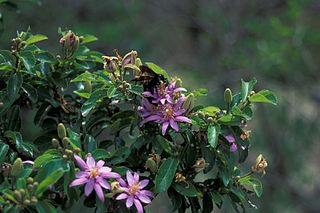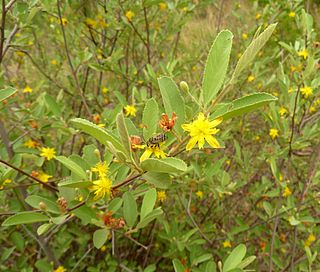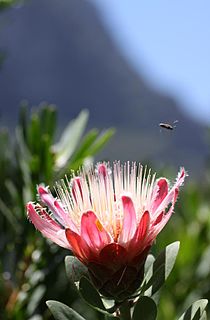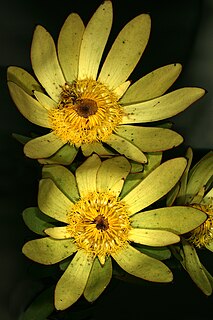
Grewia villosa is a shrub, often scrambling and hardly exceeding 4 m in height. Leaves are fairly large, serrated and heart-shaped. It grows naturally, mainly in dry habitats. It is common in most of the semi-arid parts of Eastern Africa but may now be rare in parts of its natural distribution. It can be seen in Ein Gedi oasis in Israel, and in South Africa, where it is common. Its ripe copper-coloured fruits are eaten in East Africa.

Psoralea arborea is a species of legume in the family Fabaceae. It is found in South Africa.

Grewia occidentalis, the crossberry, is a small, hardy, attractive tree indigenous to Southern Africa.
The South African National Biodiversity Institute (SANBI) is an organisation established in 2004 in terms of the National Environmental Management: Biodiversity Act, No 10 of 2004, under the South African Department of Environmental Affairs, tasked with research and dissemination of information on biodiversity, and legally mandated to contribute to the management of the country’s biodiversity resources.

Protea tenax also known as the tenacious sugarbush , is a flowering plant of the family Proteaceae endemic to South Africa and distributed in the Outeniqua, Tsitsikamma, Kouga and Winterhoek mountains as well as the Baviaanskloof. In Afrikaans it is known as Gehardesuikerbos.

Protea stokoei is a flowering shrub which belongs to the genus Protea. The plant is endemic to South Africa. It is found in the Kogelberg and Greenland mountains around Elgin.

Protea lacticolor or the Hottentot sugarbush, Hottentot white sugarbush or Hottentot's Holland sugarbush, is a flowering shrub of the Protea genus. It is also known as the Hottentotwitsukkerbos. The plant is endemic to South Africa and is found from the Slanghoek to the Hottentots Holland Mountains and also the Groenlandberg.

Protea humiflora, the patentleaf sugarbush, is a flower-bearing shrub belonging to the Protea genus. The plant is endemic to South Africa and occurs from the Du Toitskloof Mountains to the Langeberg and Waboomsberg. The plant grows to 2 m in diameter and flowers from July to September with its peak in August.

Grewia flava, the brandy bush, wild currant, velvet raisin, or raisin tree, is a species of flowering plant in the family Malvaceae, native to southern Africa. A common shrub species, it is spreading into grasslands due to human rangeland management practices, and increasing rainfall. The berries are sweet and edible, but have little flesh and so are typically collected to ferment into alcoholic beverages. The desert truffle Kalaharituber pfeilii is often found in association with its roots.

Grewia flavescens, called rough-leaved raisin, sandpaper raisin, and donkey berry, is a species of flowering plant in the family Malvaceae, native to sub‑Saharan Africa, Yemen, Saudi Arabia, and India. It is considered to be an underutilized crop, both for its fruit and its use for livestock forage.

Grewia hexamita, the giant raisin, is a species of flowering plant in the family Malvaceae, native to Mozambique and adjoining countries. It is a large tree for a Grewia, reaching 5 m (16 ft). It is the most preferred woody plant of African savanna elephants, who browse on it in all seasons, unlike even other species of Grewia.
Grewia mollis is a widespread species of flowering plant in the family Malvaceae, native to tropical Africa, Yemen and Oman. It is the source of grewia gum, an edible polysaccharide mucilage, similar in its properties to tragacanth gum.

Leucadendron conicum, the garden route conebush, is a flower-bearing shrub that belongs to the genus Leucadendron and part of the fynbos form. The plant is native to the Western Cape and the Eastern Cape, where it occurs in the Langeberg, Outeniqua Mountains, Tsitsikamma Mountains, Elandsberg and Garden Route plain.The shrub grows to be 6 m and bears flowers from October to November.

Protea venusta, the cascade sugarbush or creeping beauty, is a flower-bearing shrub belonging to the genus Protea. It is endemic to South Africa.
Leucadendron spirale, the Wolseley conebush, was a flower-bearing shrub belonging to the genus Leucadendron and formed part of the fynbos. The plant was native to the Western Cape where it was found in the Breede River Valley between Wolseley and Botha, before becoming extinct. The plant was observed only four times, in 1801, 1819, 1820s and 1933.

Serruria fucifolia, the northern spiderhead, is a flower-bearing shrub that belongs to the genus Serruria and forms part of the fynbos. The plant is native to the Western Cape, South Africa.

Serruria brownii, the bottlebrush spiderhead, is a flower-bearing shrub that belongs to the genus Serruria and forms part of the fynbos. The plant is native to the Western Cape, South Africa.

Paranomus dregei, the scented sceptre, is a flowering shrub belonging to the genus Paranomus. The plant is native to the Western Cape, South Africa.
Leucadendron gydoense, the Gydo conebush, is a flower-bearing shrub that belongs to the genus Leucadendron and forms part of the fynbos. The plant is native to the Western Cape, South Africa.

Leucadendron elimense, the Elim conebush, is a flower-bearing shrub, which belongs to the genus Leucadendron and forms part of the fynbos. The plant is native to the Western Cape, South Africa.
















